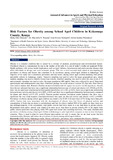| dc.contributor.author | Olutende, Micky Oloo | |
| dc.contributor.author | Wanzala, Maximilla N. | |
| dc.contributor.author | Wabuyabo, Issah Kweyu | |
| dc.contributor.author | Wamukoya, Edwin Kadima | |
| dc.date.accessioned | 2022-01-10T09:33:52Z | |
| dc.date.available | 2022-01-10T09:33:52Z | |
| dc.date.issued | 2021-04-13 | |
| dc.identifier.uri | https://doi.org/10.36348/jaspe.2021.v04i04.003 | |
| dc.identifier.uri | https://saudijournals.com/media/articles/JASPE_44_59-67.pdf | |
| dc.identifier.uri | http://ir-library.mmust.ac.ke:8080/xmlui/handle/123456789/1998 | |
| dc.description.abstract | Obesity is a complex condition that is caused by a mixture of medical, psychological and environmental factors.
Childhood obesity is characterized by rise in the number of fat cells. It is one of today’s visible yet neglected Public
Health problems with serious health implications such as type2 diabetes, hypertension and cardiovascular diseases that
affect individuals in all ages and socio-economic groups. This was a cross-sectional study aimed at investigating the
prevalence of obesity and factors that contribute to its occurrence among school-aged children in Kakamega. The
objective of the study was to determine prevalence and risk factors among school aged children attending both private
and public schools in Kakamega county. Purposive sampling was used to select the target geographical area, simple
random sampling was used to identify twenty-four schools, stratified sampling was used to select the class levels (1-4)
and systematic sampling was used to select the target population (400 pupils). Data were collected by use of Structured
questionnaire and anthropometric data sheet. Statistical package for social sciences (version 25), Epi-info, Nutri-Survey
were used to analyze data. Pearson’s Product moment correlation and chi-square was used to test the hypotheses. Results
from the test indicated that there was a significant relationship between type of school and obesity (x2= 49.626, p<0.05),
there was no significant relationship between gender and obesity (x2=2.867, p>0.05), there was a significant relationship
between leisure activity and obesity (x2=4.094, p<0.05) and there was a significant relationship between meals consumed
for dinner and obesity (x2=71.123, p<0.05). Pearson product moment correlation results indicated that there was a
significant but very weak negative correlation between time spent on physical activity and obesity. (r=0.2, p=0.038).
Prevalence of obesity among school-aged children was found to be 25.6% with more boys (27%) being obese than girls
(26%). Factors that were associated with the development of obesity were low levels of physical activity and
consumption of foods that are dense in carbohydrates and fats. In schools studied 58% of the pupils ate three times in a
day although majority of the respondents from public schools had fewer meals in a day than those in private schools.
Respondents from public schools were found to be more active than those in private schools.40% of the pupils from
public schools spent their time playing while 39% spent their leisure time watching television. This study concludes that
prevalence of obesity among school aged children in Kakamega is quite high which compares to rates in most developed
countries. There is need to plan for most efficient interventions not only to ensure that we are food secure but also
maintain healthy lifestyles and reduce the prevalence of obesity among school-aged children. | en_US |
| dc.language.iso | en | en_US |
| dc.publisher | Journal of Advances in Sports and Physical Education | en_US |
| dc.subject | Risk, Factors, Obesity, School, Aged, Children | en_US |
| dc.title | Risk Factors for Obesity among School Aged Children in Kakamega County, Kenya | en_US |
| dc.type | Article | en_US |

